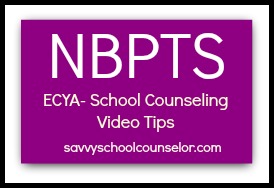National Boards: Pointers for Videos
 One very important component of your national boards portfolio will be the two videos you must submit for Entries 2 and 3. The bulk of your writing will come AFTER you have recorded your videos.
One very important component of your national boards portfolio will be the two videos you must submit for Entries 2 and 3. The bulk of your writing will come AFTER you have recorded your videos.
One of your videos will involve a whole class career lesson. The other will include you and one student needing academic counseling.
The first thing I want you to know is this: Do not simply make a video without paying close attention to the video analysis section of the entry directions. Take time first to read and understand exactly what the assessor will be looking for during the video. You will need to make sure you address each point within fifteen minutes on your videos. Fifteen minutes is the absolute maximum time your video should be. Anything more will not count toward your score and will not be viewed. PLEASE be sure to thoroughly read your Format Specifications. Specific directions for video recording are given and include “Video Recording DOs and DON’Ts.”
Here are a few important things for you to remember:
- Be sure to have a video release form for each student included in your videos.
- Remember to submit a copy of your driver’s license or any government issued ID. Your assessor will need this to confirm that the person in the video is really you. You’ll include a copy with each entry separately.
- Do NOT edit your video in ANY way. Doing this will affect your score.
- If you do happen to use an actual video tape, be sure to “cue” your video so it starts exactly where you would like the assessor to begin watching. Your fifteen minutes don’t have to include any special type of introduction. CD’s will also need to begin exactly where your fifteen minutes start.
- It’s okay if you have some students in your classroom video without release forms. They can still participate and even answer questions. Just be sure they are not visible in your recording. You can sit those students in a section behind the camera.
- Make sure you are visible at some point in the video.
- In your writing, it’s good to quote a student’s response that you are referring to just in case it seems inaudible on your recording.
My Approach
My career lesson for Entry 2 was at least 45 minutes in length, but only 15 minutes of it could be included on my video. Before even planning my lesson, I looked at each question and noted what I would need to show evidence of during my recording. This included how I determined the students understanding of the topic of career development, how I provided constructive feedback, how I ensured fairness, equity, and access for each of the students, how I used technology, and evidence of my students’ engagement in critical thinking or problem solving. That may seem like a lot to squeeze into fifteen minutes, but it CAN be done.
I followed the same process for Entry 3 using the Video Recording Analysis questions.
Pay special attention to the questions that say to “cite specific evidence from the video segment.” While some questions are things you can simply demonstrate and point out during the video (ie. Steps taken to foster a purposeful and supportive counseling environment), others will require pulling direct quotes from your students or you. Set your lesson up to include these important interactions.
I felt this post was necessary as I have heard of candidates simply recording a lesson and attempting to use it for their writing without really paying attention to what the assessors will be looking for. If you start by planning around the questions for the video analysis, you will not find yourself recording multiple videos. I recorded once for each of my videos, but pre-planning was truly the key.
Stick around! You can follow Savvy School Counselor with free email updates! As always, I’d love to hear from you. Do you have any specific questions I haven’t addressed regarding video recording?




2 Comments
Kirsten
Sure wish I knew about your blog when I was going through the process. I’m still keeping my fingers crossed while I’m waiting for my scores. It shouldn’t be much longer, though!
Pingback: